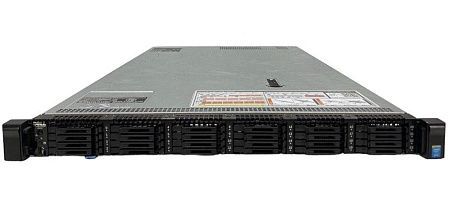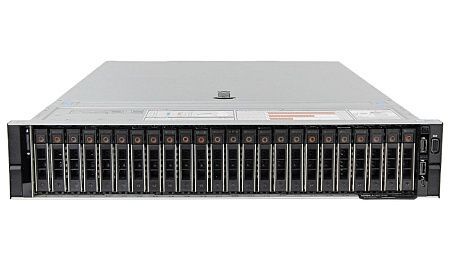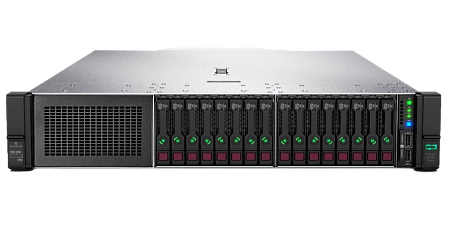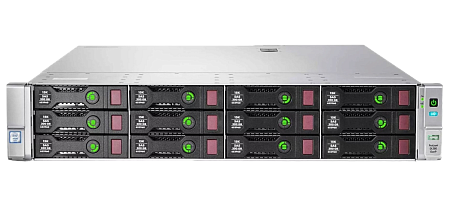In this review, we will look at the top 10 best software-defined storage (SDS) solutions, according to the Peepshot portal research. The data is presented according to ranking by popularity on the Internet.
1. Nutanix Acropolis AOS
Nutanix offers a transparent, new-generation software-defined storage solution. The Nutanix Xtreme platform provides an end-to-end solution that includes computing, virtualization and storage. This makes it possible to greatly simplify the infrastructure of data centers. The following advantages are available to Nutanix users:
-
determining the possible performance level,
-
linear scalability of cloud-type computing infrastructure.
Nutanix Acropolis is an operating system also widely known under another name – Acropolis Operating System (AOS), which has an artificial intelligence core. It operates on top of the embedded Nutanix Acropolis Hypervisor (AHV) + other vendors hypervisors (for example, VMware vSphere ESXi and Microsoft Hyper-V). Nutanix Acropolis is designed in order to manage and virtualize the storage pool of containers and volumes with the use of the PCI Directpath I/O algorithm.
Nutanix Acropolis AOS is installed as a Controller Virtual Machine (CVM) on top of the hypervisor in order to control a Nutanix computing platform.
Nutanix Acropolis can be roughly divided into three important parameters:
-
Distributed Storage Fabric,
-
App Mobility Fabric,
-
AHV hypervisor.
Three third-party hypervisors (ESXi, Hyper-V, Citrix Hypervisor) are also supported by Acropolis.
Instead of using expensive interconnects or traditional SAN/NAS storages, Nutainx Acropolis (AOS) combines storage and server computing resources into a single basic cluster unit – a standardized scalable architecture without points of failure.
Storage management is based on the use of virtual machines, and I/O functions at the VM virtual disk level. This software solution runs on multi-vendor storage nodes, which can be flash drives used to maintain an optimal level of performance, or a hybrid mechanism that includes solid-state drives and hard drives to maintain performance and capacity.
DSF uses intelligent data placement programs to automatically distribute data in a cluster across various storage device levels. The best performance results are achieved through the extensive use of these programs, ensuring that key data is available in memory or in flash memory on a node locally accessible to the VM.
Nutanix has become a leader in hyper-converged technologies with the Nutanix Acropolis Operating System (AOS).
2. StarWind Virtual SAN
SDS StarWind is a virtualized network storage system used for the needs of small and medium-sized businesses. This system "mirrors" the internal hard drive and flash memory between the hypervisor servers, resulting in a reduction in the need for additional devices and maintenance.
StarWind VSAN can help you create a virtualization infrastructure from the initial stages (Star Wind Hyper Converged Appliance is required). Besides, it will also be useful on previously created storage servers.
3. StarWind HyperConverged Appliance
Here we are talking about a ready-made platform with hardware and software (base – StarWind Virtual SAN). This solution may be perfect for those who plan to create and maintain infrastructure from the initial stages and at low cost.
4. DataCore™ SANsymphony™
DataCore™ SANsymphony™ is an enterprise-class SSD system that is characterized by high levels of efficiency, availability, convenience, flexibility, productivity and, last but not least, low cost of ownership. The main users of this platform are listed below:
-
Stadtverwaltung Heidelberg.
-
NetEnt.
-
Volkswagen.
-
Maimonides Medical Center.
-
Bitburger.
-
University of Birmingham.
-
The Biodesign Institute.
-
ISCO Industries.
-
The Royal Institute of International Affairs.
-
Quorn Foods.
-
Pee Dee Electric Cooperative.
-
United Financial Credit Union.
-
Colby-Sawyer College.
-
Mount Sinai Health System.
-
Derby Supply Chain Solutions.
-
Mission Community Hospital.
-
Bellarmine College Preparatory.
5. Zadara
Zadara is a comprehensive enterprise data storage solution that includes all the basic functions required for any storage of this class. The system is fully managed 24/7 by the supplier. Using Zadara reduces OpEx due to the availability of the pay-per-use payment model. The Zadara Storage solution is universal and convenient, as it makes possible to deploy storage for a wide range of data types (object, block, file), using any protocol (NFS, FC, iSCSI, iSER, Swift, CIFS, S3), as well as in any location (cloud, local, hybrid – worldwide).
6. НРЕ StoreVirtual
HPE StoreVirtual is a software and hardware solution that is the best option for both branches of large organizations with small IT environments, and for offices of small and medium-sized businesses. In the case of branches and remote offices of large companies, this shared storage system is used to implement virtualized servers.
With HPE StoreVirtual storage, you can take full advantage of server virtualization with high levels of cost-effective availability, disaster recovery and easy iSCSI-based management. To form a single pool of resources, HPE StoreVirtual nodes use storage clustering. This in turn gives businesses the opportunity to make purchases only for current needs, with the ability to scale for uninterrupted operation.
7. Red Hat Ceph Storage
Red Hat Ceph Storage is an upgraded data storage platform, as well as a successful combination of the latest reliable version of open source SelfStorage (+ improved functionality and Red Hat support) and a simplified algorithm for easy scaling of companies' storage systems depending on changing needs and requirements.
Red Hat Ceph is specifically developed for today's workloads. Even as the number of clusters increases, Red Hat Ceph is designed to provide predictability that traditional network-attached storage (NAS) and storage area network (SAN) approaches do not provide. Red Hat Ceph is also used for:
-
Storage as a service (STaaS).
-
Data analysis.
-
Machine learning (AI/ML).
-
Archiving and backup.
The main advantages of Red Hat Ceph Storage
-
Security – ensures protection from unauthorized access, hardware failures, possible user errors, various threats and cyberattacks. There are various options for maintaining data reliability and fault tolerance parameters. Support for encryption at rest and end-to-end encryption (cryptography approved by the NIST) is included, as well as erasure coding and replication operations.
-
Simplicity and convenience – backward compatibility, integrated local dashboard, simple installation process, fast automation and important analytical data.
-
Scalability – Ceph can scale from small volumes to petabytes of information and countless objects storage, while its object interface and highly efficient BlueStore storage architecture ensure predictable performance.
8. Microsoft Storage Spaces Direct
To create software-defined, secure, highly available, easily scalable and low cost compared to traditional SAN or NAS storage arrays, the MS Storage Spaces Direct (S2D) software platform uses standard COTS (Commercial off the Shelf) servers and standard drives. Its converged or hyper-converged architecture simplifies data collection and deployment and provides high working speed and high level of efficiency through a combination of features such as caching, storage tiers, erasure coding (+ use of NVMe drives and RDMA networking).
Storage Spaces Direct virtualized storage provides opportunities to:
-
Use low-cost storage with external storage devices (or without them).
-
Manage a number of physical storage sources as a single virtual facility.
-
Combine different types of storage into a shared virtual storage pool.
-
By adding new disks, you can easily distribute storage space and scale virtualized storage as needed.
A cluster with S2D can be deployed in the following ways:
-
Hyperconverged deployment: simultaneous scaling of computing and storage resources is available thanks to the operation of the Hyper-V hypervisor and S2D storage in a single cluster.
-
Disaggregated deployment: computing resources are running in one Hyper-V cluster and S2D storage in another. Clusters are individually scalable in order to ensure fine-tuned management.
9. IBM Spectrum Virtualize
IBM Spectrum Virtualize is a software platform bundled with IBM Enterprise Storage arrays technology that provides the opportunity to manage your storage array as a single pool of capacity. Many storage management functions, including automatic tiering are storage-wide and can be managed from a "single panel".
The expansion of public cloud services has led to the need for IBM to add cloud features to enterprise storage using Spectrum Virtualize for Public Cloud. This in turn increased the software's abilities to control appropriate processes in local, IBM Cloud, Azure, AWS storages.
While following the principle of a single point of management of aggregated capacity, it becomes possible for users to implement IBM's storage management, performance and fault tolerance capabilities in hybrid storage systems that can be deployed in the cloud, on-premises and even in third-party storages.
IBM Spectrum Virtualize can be considered a hybrid cloud-enabled storage operating system. For example, Spectrum Virtualize provides a secure computing environment, with the ability to copy snapshots of business data in individual order between the on-premises system and the cloud. This can be useful for disaster recovery scenarios.
IBM Spectrum Virtualize has come a long way from IBM SAN Volume Manager, which makes it a reliable and high-quality storage virtualization system.
10. StorPool
StorPool is a data storage system designed taking into account intelligent protocols, operating on standard servers, on the basis of which it further forms scalable software-defined storage. StorPool is block storage with a range of additional functions. With its advanced fully distributed architecture, StorPool is considered one of the most efficient, reliable and fast software storage platforms.
In order to create a single pool of shared cloud storage, StorPool uses a combination of the capacity and performance of connected local DAS devices (NVMe, SSD, HDD) from a certain number of standard servers. StorPool operates on a cluster of standard servers in a fully distributed architecture without shared access running GNU/Linux. All functions are performed in the same way by all servers.
The software includes 2 components: a storage server and a storage client. Both are installed on each physical server (host, node). The converged infrastructure is represented by a host that can be both a storage server and a storage client. In the /dev/storpool/ directory, StorPool volumes are displayed as local block devices to storage clients. All clients can read and record data on volumes at the same time. Synchronous replication protocol ensures consistency. The StorPool client interacts with all StorPool servers as well.
You can use StorPool JSON API or CLI Volume Manager to create volumes for 1 or more block storage devices. Redundancy is guaranteed by several copies of data that are synchronously recorded to the cluster.
StorPool also guarantees a high level of flexibility in volumes management. StorPool does not have a clearly-defined hierarchical storage structure, it is responsible for creating a single pool of data storage, which is based on all the capacity and efficiency of conventional disks. When a disk is added to the StorPool cluster, it increases the cluster capacity for already existing and new data.
An improved software RAID between servers with end-to-end data integrity verification can be considered a guarantee of redundancy by using a synchronous replication algorithm. Typically, the data requested by one client is on disks located on all servers in the cluster. This solution guarantees reliable real-time load balancing and a high level of performance. Data placement and replication are selected individually for each volume.
StorPool supports a wide range of different hypervisors such as ESX/ESXi, Windows Server, VMware vSphere, Hyper-V and many others. Access to the StorPool shared storage service is possible via the iSCSI protocol.
Today, StorPool is defined as a standard SAN for hypervisors and operating systems. StorPool supports Linux with KVM, LXC, LVM, Docker by default. It is also compatible with any other technology connected with the Linux storage stack. StorPool supports libvirt, OnApp, Proxmox, as well as specific cloud management programs. StorPool is integrated with CloudStack, OpenStack, OpenNebula. It is compatible with many file systems (for example: ext4 and XFS), with systems used to work with block devices (for example: OCFS and GFS). If we are talking about VMware/Windows, StorPool is displayed as one large block formatted in NTFS, VMFS or FAT.
Specialists of our company are ready to help you purchase the server and select the necessary server configuration for any required task.




















































